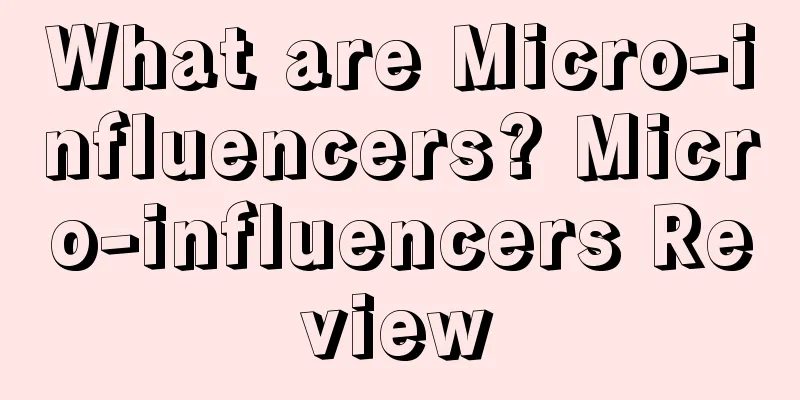What are Micro-influencers? Micro-influencers Review

Micro-influencers are a type of Internet celebrity. Unlike the traditional celebrities, experts or public figures that everyone knows, they are actually a group of passionate and energetic people who are keen on using various social media to tell and promote a certain category, a certain brand or simply an individual's story and profit from it .introduceMicro opinion leaders are ordinary consumers who have their own areas of interest or specialization, such as gardening enthusiasts, shopaholics, fitness enthusiasts, academic masters, travel experts, etc. Although they are not at the level of Internet celebrities, they have a say in this field among their relatives and friends. Micro-influencers need to cooperate with a large number of ordinary consumers, attack from multiple points, create influence from the bottom up, and also play a role in dispersing risks. InfluenceMicro-influencers have efficient brand communication, marketing placement and can even create simple and high-speed fanatical fans, which can achieve the effect of deep communication. Usually, Micro-influencers may only have thousands or tens of thousands of fans at most. value1. Micro-influencers have higher engagement rates Data shows that micro-influencers can achieve more flexible and efficient personalized marketing (the so-called "one thousand faces for one thousand people") compared to big influencers with hundreds of thousands or millions of fans. For niche brands, vertical brands, and even personalized brands, the user conversion rate, loyalty, and high customer unit price brought by personalized marketing are not something that big influencers can sustain. 2. Micro-influencers have a larger target audience 3. Micro-influencers are more affordable Compared with online celebrities, micro-influencers obviously have a more reasonable ROI in terms of cost. Usually, a cross-border e-commerce celebrity or a celebrity with millions of fans can post a single Instagram Posts promoting products or brand partnerships can cost as little as $75,000 or more. In contrast, 97% of micro-influencers only make about $500 to promote an Instagram post. 4. Micro-influencers are more authentic defect1. Each Micro-influencer can reach a small number of people, so an automated delivery method is needed 2. Micro-influencers have varying levels of content production skills. Advertisers need to provide basic materials and creative routines, and may even use a programmatic creative model. 3. Avoid being as annoying as WeChat business Advertisers just want to use payment to encourage consumers to share their experiences 4. The biggest change of micro-influencers is that they are manageable and monitorable Advertisers must clearly define their ROI targets for their advertising expenditures and monitor and optimize during the advertising process. References
|
<<: What is Selling Manager? Selling Manager Review
>>: What is Buzz Sumo? Buzz Sumo Review
Recommend
Attention! Amazon blocks some delivery windows in December!
Amazon warehouse overflows are an increasingly se...
What is efunsell overseas warehouse? Efunsell overseas warehouse review
efunsell overseas warehouse is a European overseas...
Amazon raises more than one million pieces of medical protective equipment worldwide to support the fight against pneumonia
Now, the beginning of spring has arrived, and we a...
Just now, another domestic cross-border giant plans to go public!
1 PingPong plans to list on Shenzhen Stock Exchan...
What is Email Hunter? Email Hunter Review
Email Hunter is an email address search tool. Just...
What is Lilanda? Lilanda Review
Shenzhen Lilanda Technology Co., Ltd. (hereinafter...
It’s so hard for sellers: their infringements are targeted by rogue law firms, who demand high settlement fees!
Experienced cross-border sellers should all know ...
mParticle and Shopify cooperate to provide data support for Shopify sellers
It is learned that Shopify recently announced a pa...
What is Love Crafts? Love Crafts Review
Love Crafts is a digital platform for craftspeople...
Amazon's pillars are hit again! Its local business is stabbed
Recently, Bloomberg reported that the U.S. Federa...
What is Qaya? Qaya Review
Qaya is part of Area120, an incubator for new prod...
(Operational Tips) How to do a good job of Amazon QA and boost listing traffic
When it comes to listing optimization, many selle...
Entire categories disappear on Amazon? Something big happened right after Primeday
Membership Day on the US site officially ended thi...
The autumn sale is coming, but it will trigger a ban crisis?
During the Mid-Autumn Festival and National Day ho...
Cargo volume at various ports plummets again! Amazon's new system goes live on April 4
In the past two days, relevant US agencies announc...









